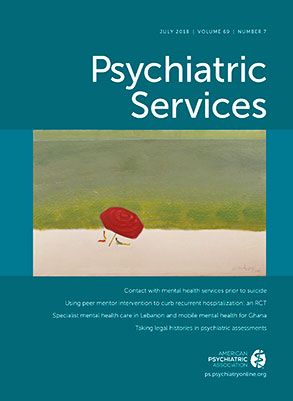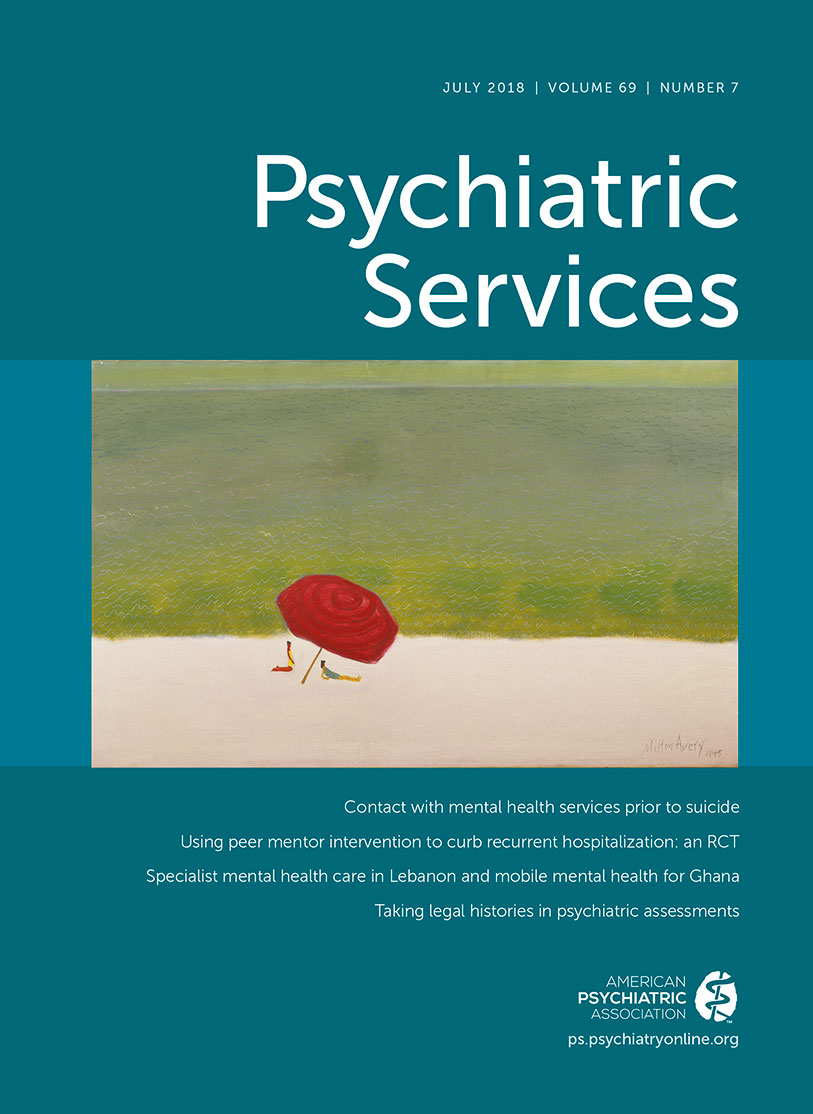The Problem
Although serious mental illness affects up to 5% of the general population, police estimate that 7%−10% of their encounters involve individuals with mental illness (
1). Individuals with mental illness are more likely than those without mental illness to be arrested for the same behavior (
2). Two million individuals with serious mental illness cycle through our nation’s jails every year. The rate of serious mental illness among jail inmates is about 17%, and most have a co-occurring substance use disorder (
3,
4).
Inmates with mental illness tend to stay in jail and prison longer than others charged with similar offenses and are less likely to be approved for probation or parole (
5). On release, individuals, particularly those with co-occurring illnesses, have a greater chance than other offenders of incurring new charges (
6). Recidivism is often the result of violating the conditions of probation or parole rather than committing a new crime (
6). These violations might not be willful but instead might be the result of the disorganizing effects of the mental illness itself or secondary to housing instability, lack of transportation, or other effects of poverty.
Community reentry is especially important for African-American citizens with mental health challenges, for they are disproportionately affected by incarceration (
6). Narrow windows of release, unpredictable discharges, limited supportive housing options, and delayed receipt of general medical and mental health services in the community exacerbate the challenges of societal reintegration.
Efforts that connect returning citizens to treatment and resources such as housing and employment are cost-effective and help reduce recidivism (
7). However, needed services often are not available or accessible. Between 2009 and 2011, states cut more than $1.8 billion in mental health funding for children and adults; for 11 states, mental health budget cuts accounted for 12%−35% of their overall state mental health general-fund budget (
8). These cuts translate into decreased community resources, increased emergency room visits and inpatient hospitalizations, increased homelessness, and premature death. While these budgets were being slashed, total correctional expenditures increased 145% from fiscal year 1986 to fiscal year 2001 (
9). In the absence of effective services, the symptoms and secondary effects of mental illness are often criminalized and lead many individuals into the criminal justice system.
Conceptual Foundations for Community Responses
The sequential intercept model is a conceptual framework that suggests that each point at which an individual might have contact in the criminal justice system—from an encounter with law enforcement on the street through the person’s release and return to the community—presents a public health opportunity to divert that individual to the treatment system. There are emerging best practices at each intercept point that communities can adopt to reverse the overrepresentation of people with mental illness in the criminal justice system. These diversion practices require a willingness among leaders and practitioners at all levels of the mental health, addiction, and criminal justice systems to work together and to do things differently (
10).
One critical area that needs a different response is addressing what are known as criminogenic risk factors for recidivism. Unfortunately, the expertise and technology developed in the criminal justice system to address these factors have not yet been integrated into most mental health treatment systems (
11). The risk-need-responsivity model is an evidence-based approach to increasing the success of interventions to decrease recidivism and is based on three principles. The first principle is risk, which refers to appropriately matching treatment to the person’s risk of recidivism. The second is need—interventions should address the needs corresponding to the person’s criminogenic risk factors. The third principle is responsivity, which calls for tailoring programs according to the person’s learning style, cognitive abilities, motivation, and culture.
In this model, serious mental illness is a responsivity factor. It is perhaps surprising that justice-involved individuals with serious mental illness score higher than offenders without serious mental illness on criminogenic risk factors that predict recidivism (
12). To effectively address the overrepresentation of individuals with serious mental illness in the criminal justice system, it is critical to assess criminogenic risk and address the corresponding needs (
12).
Recommended Solutions
There are many examples of promising practices that increasingly are being adopted. One such development is the implementation of specialized police-response programs, such as the crisis intervention team program, which offers a community policing model to improve crisis response. The use of a validated brief screen at the time of jail booking to identify individuals with a serious mental illness, substance use disorder, or both improves treatment and reentry planning. Jail policies to suspend rather than terminate Medicaid coverage provide immediate access to treatment, including prescribed medication, to individuals on release. Finally, forensic assertive community treatment teams integrate probation officers into the interdisciplinary mental health treatment team to improve the effectiveness of community supervision.
An effort that has received widespread support is the Stepping Up Initiative, spearheaded by a partnership among the National Association of Counties, the Justice Center of the Council of State Governments, and the American Psychiatric Association Foundation. Every U.S. county has been asked to sign on to work together across county systems to reduce the number of people with mental illness in local jails (
13). So far, 398 of the nation’s 3,142 counties have joined (
13).
Understanding that what is counted is what gets attended to, Stepping Up emphasizes the need to collect data. The initiative targets four key outcome measures that the partners can examine at baseline to characterize the extent of this problem. They also can monitor these measures over time to evaluate the impact of any interventions, including the number of people with serious mental illness booked in jail, the length of time people with mental illnesses remain in jail, connections to treatment, and recidivism.
If these data are not currently available, an essential first step is to establish the processes, policies, and monitoring capacity to collect and track them. County leaders have considerable potential to mobilize change to improve the criminal justice system, reduce unnecessary costs, and protect public safety while addressing mental health. Ideally, every U.S. county will join the Stepping Up initiative. Next, they must convene the group of committed cross-system stakeholders needed to create change. Implementation efforts may be informed by a recent monograph,
Reducing the Number of People With Mental Illness in Jail: Six Questions County Leaders Need to Ask (
13).
Ohio has taken a statewide approach to encourage its 88 counties to participate in Stepping Up. So far, 34 Ohio counties have signed on. To help move their effort forward, 12 counties engaged Ohio’s Criminal Justice Coordinating Center of Excellence to facilitate Sequential Intercept Mapping, a 1.5-day workshop to facilitate collaboration; identify ways to reduce barriers among the criminal justice, mental health, and addiction systems; and develop initial action plans (
14). Ohio’s statewide Stepping Up Steering Committee has developed a consensus definition of serious mental illness so that all counties are measuring the same population of interest, and an increasing number of county jails are adopting validated jail screening instruments for use at booking.
An Opportunity to Move the Work Forward
States and counties currently have a great opportunity to move this work forward. Helping policy makers understand that an investment in community-based services will lead to substantial savings by reducing criminal justice system costs is an essential task to leverage public and political will. In Texas, a jail bed for an adult costs $137, and an emergency room visit costs $986, whereas community-based treatment services have an average cost of $12 a day (
15). Programs and policies that help keep people with mental illness out of jails and prisons can result in overall cost savings that will help state governments struggling to balance budgets.
The 21st Century Cures Act incorporates the Comprehensive Justice and Mental Health Act, which reauthorizes funding for state and local governments to design new approaches to reducing the number of people with mental illness in jail and expand access to treatment courts for veterans. The Cures Act also incorporates the Mental Health and Safe Communities Act, which creates the National Criminal Justice and Mental Health Training and Technical Assistance Center and supports state and local efforts to improve community capacity to recognize and respond to mental illness. The Cures Act offers a variety of funding opportunities to communities to improve their mental health and addiction systems and to develop programs at each of the intercept points. Policy Research Associates has created a template of funding opportunities that the 21st Century Cures Act provides through both the U.S. Department of Health and Human Services and the U.S. Department of Justice (
https://www.prainc.com/curesact-sim). As a result of these opportunities, the solutions are now within reach for leaders with the will to act.

